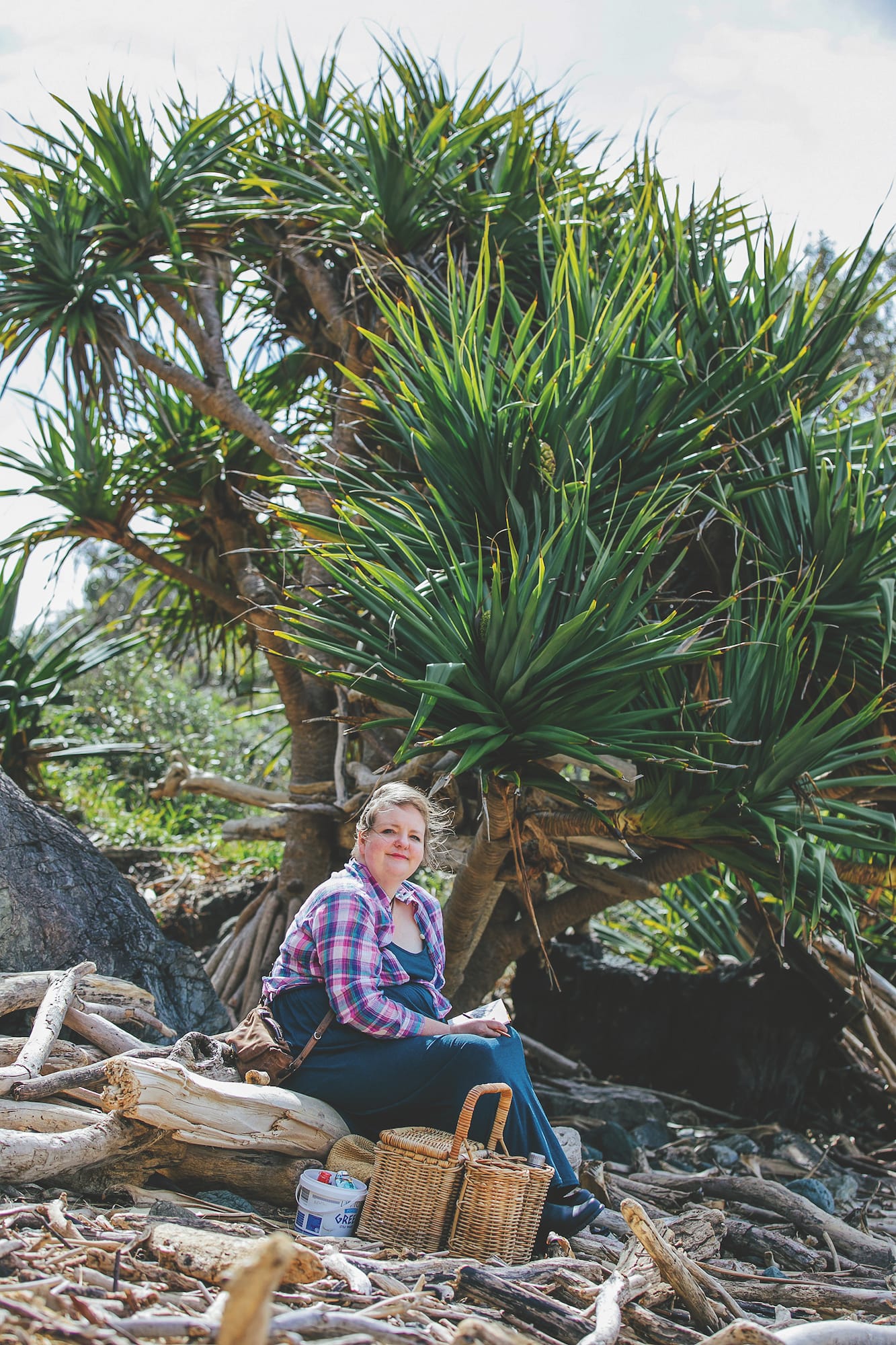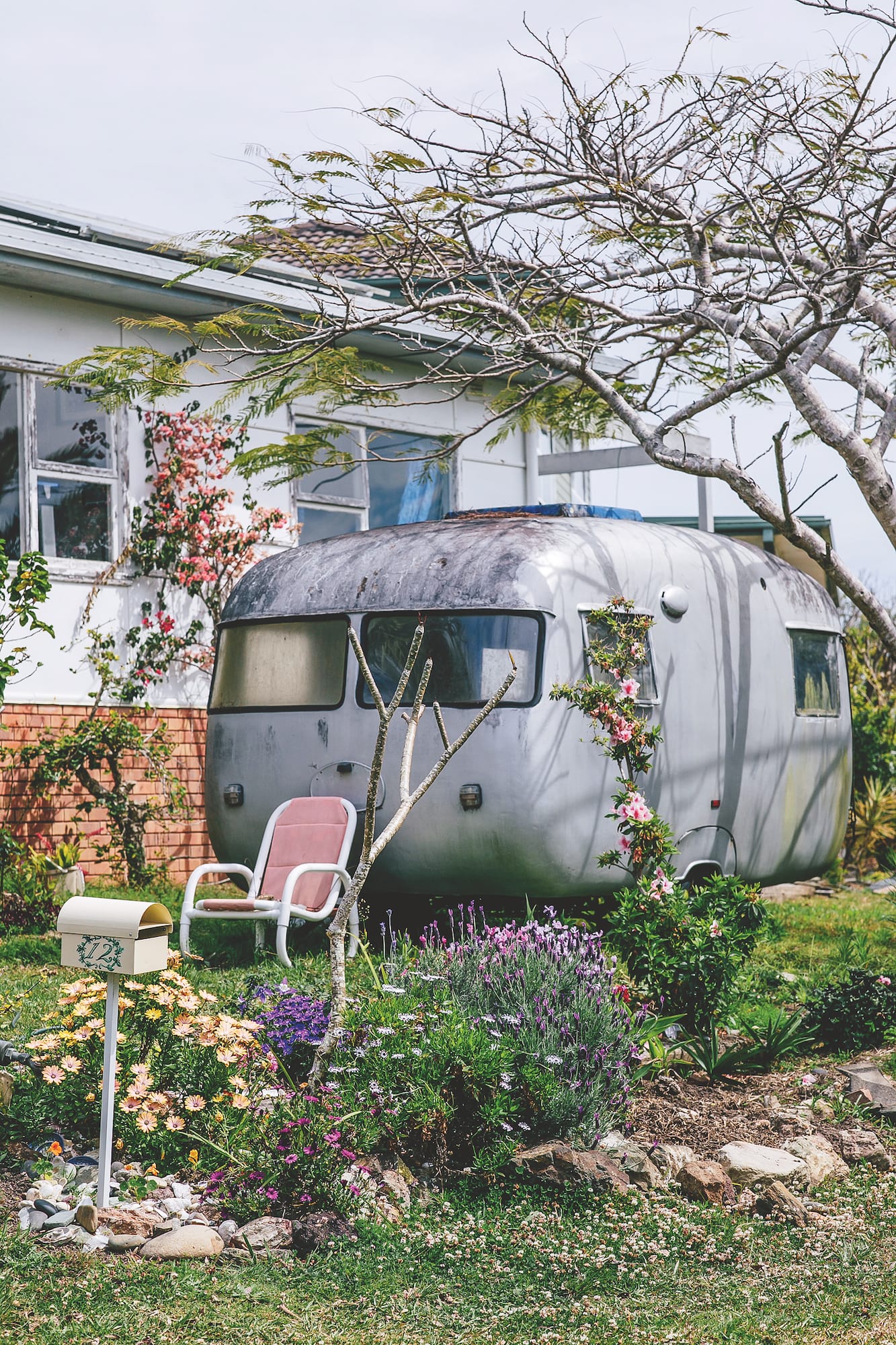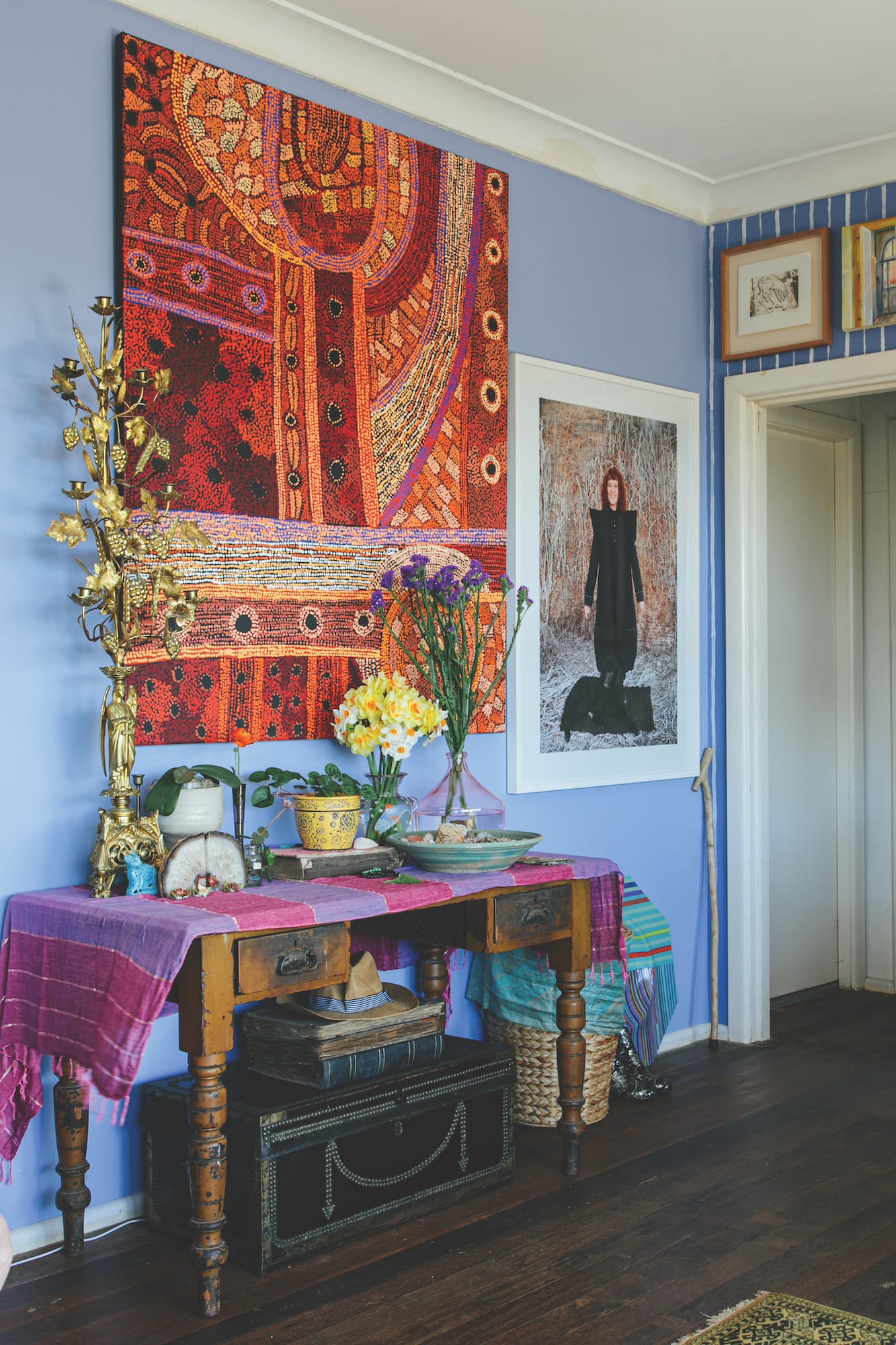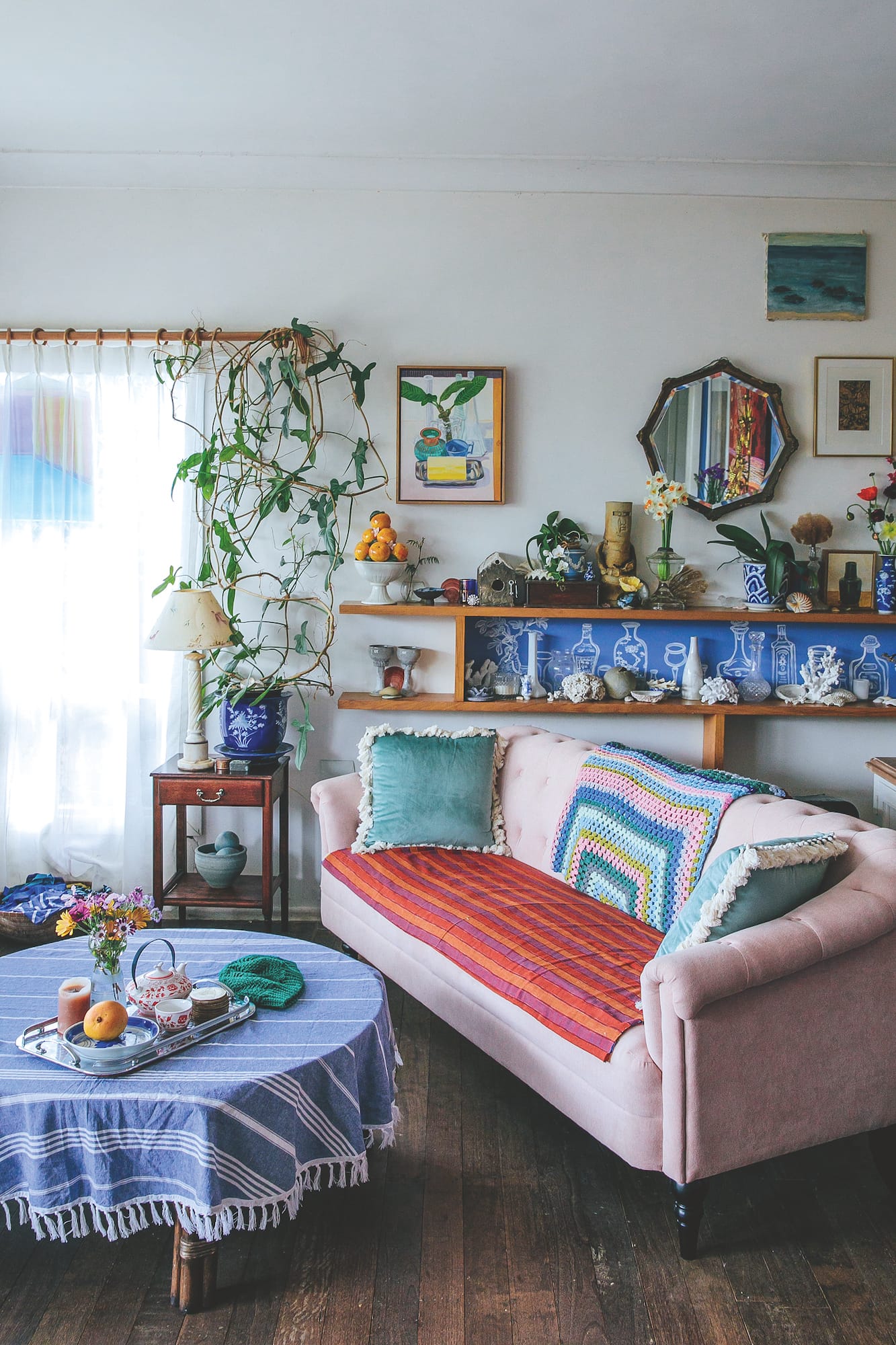
Artist Kiata Mason found herself returning time and again to her grandmother’s house on the east coast, eventually realising it was her home, too.
Words Ceri David
Photography Elise Hassey
Kiata Mason is seven, and hiding under the old water tank that stands on stilts behind her grandmother’s house. The summer sun is white hot, toasting the garden and making her secret patch of shade all the more blissful. It’s a memory, of course, because Kiata Mason is a fully grown woman now, and the water tank is long gone, but the moment is as vivid as ever. ‘It was so cool underneath, and covered with jasmine and honeysuckle,’ she says, with a deep breath. ‘That smell.’
Words do a good job, but it’s the type of experience Kiata might prefer to convey using paint. Her work, which has made her a finalist in a long list of competitions—the Dobell Prize for Drawing, the Sir John Sulman Prize and the Paddington Art Prize, as well as winner of the 2018 Muswellbrook Art Prize Works on Paper—is saturated with nostalgia and colour. As is the house.
It was the mid-1980s when Beatrice, Kiata’s Gran, bought the property in sun-bleached Lake Cathie, two-thirds of the way up the New South Wales coast. Even late in life, Beatrice would go out boogie-boarding most mornings, and enjoyed adventures with her surfer boyfriend in the old caravan that’s still out front, slowly falling apart.
Kiata, meanwhile, lived all over the place—Sydney, Armidale, Canberra, Newcastle, Port Macquarie—but made Lake Cathie her home base, returning as often as she could and building up a lifetime of memories.

In 2013, when Alzheimer’s disease began to chip away at Beatrice’s well-being, Kiata made the decision to move in, relocating from Sydney where she’d just graduated from the National Art School. Not everyone was supportive. ‘There was quite an aggressive response,’ she recalls. ‘People said, “Don’t do that. You’re going to kill your career.”’ The sentiment is not uncommon, but expressed so bluntly, without the usual sugar-coating, it feels especially cold.
‘It’s a choice that a lot of people run from, but it threw me down this rabbit hole of Why can’t they understand why I would want to do this?’ she says. ‘In some cases, I think it came from guilt that people weren’t doing more themselves for family members. I know the modern economy doesn’t necessarily facilitate looking after your elders. Then there’s the emotional gap, especially with Alzheimer’s, in that you love the person unconditionally, even though they’re no longer able to reflect back the stories that reinforce your identity. It’s definitely not easy. It tests you. But there were also people saying, “You’re wasting your life doing that.” I don’t see it that way.’
Kiata had looked after her for eight years when Beatrice passed away in June 2020, prompting another deluge of commentary, loaded with vicarious relief that she could leave at long last, followed closely by confusion when she didn’t.
‘They’d say, “It’s your gran’s house,” and “isn’t it hard being surrounded by all her stuff?” But she was my second parent, and the house is filled with my stuff just as much as hers.’ There’s a heavy pause. ‘All my dogs have been buried in the backyard. How could you not perceive that this is my home?’


Clearly, while onlookers viewed her bereavement as a ‘difficult’ period—something to move on from, emotionally and geographically—Kiata had a different perspective. ‘I think you’ve got to embrace all the parts of life,’ she says. ‘I had a lot of grief, but there was no regret in the grief, you know? So, in a way, it’s very calming living here. I also think some people have a fear of living by themselves. I don’t.’
And so she stays.
It’s tempting to say the house has seen better days, but that may not be true. ‘I imagine it was a homeowner build,’ says Kiata. ‘It’s asbestos through and through. There’s subsidence. I’ve got leaks in two parts of the house, one of which is going through something electrical. We’ve had termites. The bricks at the front are turning into dust and everything metal has rusted. But it’s wonderful. This house has saved me: you need stability when other parts of yourself are unravelling.’
Some of this soothing influence comes down to the location: five minutes’ walk from the Pacific Ocean. During the daytime, the sound of the surf interrupts rainbow lorikeets, willie wagtails and kookaburras chattering in the mango tree outside, but it’s after dark when it really comes alive. ‘It roars,’ says Kiata. ‘It’s all you can hear at night, and if there’s a storm—oh my god—you’re confronted by this immeasurable force that’s so much bigger than you, which is exactly what you need if you’re going through petty human realisations.’
Finding the solitary, salty, sandy moments she prefers has become tricky lately. ‘With Covid, now that everyone’s at home, there’s always at least a dozen families on the beach, and I’m not entirely happy about it. I’m like, “What are you doing here? I’m having a moment with the elements. Fuck off!”’She collapses with laughter.




If it’s not already crystal clear, this is a woman who has always been comfortable running her own race. Becoming an artist was never a choice; it’s simply what she has done, from the start. ‘I was always one of those kids: you could give me paper and a pen or some paint and I’d be in the corner, drawing happily for hours.’
The closest she came to a career detour was an early flirtation with the law, based solely on her mother’s love of British TV drama Rumpole of the Bailey. ‘I remember dressing up and Mum gave me an old briefcase,’ she says. ‘A week in, I realised I was taking time out to do drawings surreptitiously behind my play lawyer stuff. It was hopeless. It was just going to be art for me.’
By the time she turned eight, friends’ parents were buying pieces of her work. In the first year of high school she got a gig drawing houses for real estate ads in the local newspaper.
These days, Kiata focuses mainly on still life and landscapes, finding inspiration in everyday life. Only that’s not quite how it works, apparently. ‘I think there’s this romantic idea that you have to wait for inspiration to come along. In reality, it’s more important that you pull yourself out of bed, make a coffee, get the paints out and start.’
Of course, in this treasure trove of a house, simply opening your eyes yields so much. Shelves are stacked high with figurines, crockery, shells and candlesticks. Colour bombards the eye from every direction. Surfaces are layered with blankets, tablecloths, posters, art.
‘Neither of us have ever been minimalists,’ admits Kiata. ‘Gran was probably more minimal than me, but by the time I moved in, she’d become a total hoarder. If I put something in the bin, she’d go and get it back out again.’
In her studio at the back of the house, a record player sits on an antique plan chest, with a leaning row of vinyl. While painting smaller pieces, she’ll listen to one album over and over; for longer work, she’ll select a few to rotate. ‘I basically just accepted all of Mum’s tastes—your David Bowie, your Bob Dylan, your Janis Jopli —and then kept adding to it,’ she says, pointing to a music library that also includes Billie Holiday, Vivaldi and some of what she calls ‘candy-style dance music’.
‘There’s a lovely second-hand record store in Port Macquarie. I go in and say, “My mood is this; what shall I listen to?” or “I remember this person, and I think they were from this era, and they had a really great, green jumper at one stage”. I never remember their name or the band, or even a song, exactly, but I’ll remember all the sideline things, so it’s a kind of mental charades for them to try and piece together what on Earth I’m talking about.’
That mix-and-match patchwork of moods and references shows up in her still-life works. A vase of flowers might be positioned with a Jimi Hendrix album, a piece of toast, an iPhone and a collection of her grandmother’s trinkets. Once in place, they won’t be touched until the work is complete. ‘It’s a fight to get the painting done before the flowers die, especially because they’re often right at the front, so they have to be painted last. You need a lot of energy, and a couple of days put away.’
That composition is key. ‘It’s very staged. I haven’t just walked past and gone, “Oh, that looks quite nice”.’ Her landscapes, on the other hand—often of rocks at the water’s edge—are a response to something naturally occurring, though there’s still an element of manipulation. ‘I’ll go out there and sketch or use watercolours and I’ll take some photographs. But I tend to do it half from memory. I’m not trying for reality. The colours are far more emotional than they are realistic.’

Her next exhibition, My Home by the Sea, will be the first since her grandmother passed away, and centres on the enormous role this little house near the ocean has played in Kiata’s life.
‘I think with everything that’s happened—and continues to happen—the comfort and feeling of continuation I get here is so important,’ she says. ‘There’s a connection with the thundering of the waves and the taste of salt in the air that gives it a real sense of place. It feels hopeful and healing.’ @kiatamasonart
My Home by the Sea is showed at AK Bellinger Gallery in Inverell, NSW, 20 November to 1 December 2021; akbellingergallery.com